As an architectural historian and preservationist I have been trained to think about historic buildings and neighborhoods in a fairly focused way. Changes to old buildings should be sympathetic to the structure’s original design and be appropriate in terms in size, scale, materials and decorative details. Ideally, improvements to historic buildings should meet the Secretary of the Interior’s Standards for Rehabilitation of Historic Buildings (SOIS), developed by the National Park Service to define the best treatment practices for National Register eligible and listed properties. The SOIS apply absolutely for properties pursuing state or federal historic rehabilitation tax credits or properties subject to SHPO project review due to the use of public funds or permits.
Certainly the need for such standards is evident when we view the often jarring remodels (remuddles?) that have been done, especially to commercial buildings in traditional downtowns. Giving the first floor a snazzy new look while ignoring the upper stories has long been a budget-minded approach to making old buildings look fresh or more economically viable. Undoing the bad ideas of the previous property owners was and is a big part of the National Trust for Historic Preservation’s very successful Main Street Program designed to revitalize historic commercial areas in part by encouraging a return to the authentic design and character of the buildings. Peeling off the blank metal screens installed in the 1960s to hide late 19th century downtown buildings makes a big visual impact and helps to restore a real sense of place. As a former Main Street Manager, I offered suggestions regularly about ways to rehabilitate storefronts and restore the harmony of the streetscape. I also saw many design horror stories where cheap or inappropriate fixes ruined the architectural character of old buildings. Tiny infill windows, faux colonial storefronts and aluminum covered cornices were the bane of my Main Street Manager life.
Insensitive first floor remodeling mars the architectural appeal of old commercial buildings
So, imagine my surprise when I discovered that maybe there is a very different way to think about historic preservation and appropriate design for old buildings. A recent visit to South Street in Philadelphia illustrated the point. The creative juxtaposition of new and old seems to really work there to make a vibrant and colorful neighborhood where the unique is appreciated and the usual preservation rules do not seem to apply. Some of the most visually intriguing elements of the South Street neighborhood would most definitely NOT meet the SOIS, but does it matter? (South Street is not located in any recognized historic district.) The neighborhood has its own quirky personality, a blend of new and old buildings and colorful murals. Interestingly, South Street is just a few blocks from one of the most celebrated and carefully managed historic neighborhoods in Pennsylvania, Society Hill. (The Society Hill Historic District and nearby Southwark and Old City Historic Districts were listed in the National Register in 1971 and 1972, among the earliest NR districts in Pennsylvania.) Of course South Street and Society Hill are vastly different in terms of property types, historic use, level of architectural integrity and historic district status. Yet both neighborhoods help tell the story of Philadelphia, a complicated, multi-layered history with a variety of perspectives.
South Street Philadelphia neighborhood streetscape
Colorful murals and signs are a part of the neighborhood character on South Street
While the neighborhood is mostly turn of the century three story brick buildings, Johnny Rockets adds a cool, streamlined mid-20th century appeal to a prime corner
So maybe successful preservation is not such a one size fits all endeavor? As preservationists we encourage all communities to understand the impact of design in creating and maintaining a visual identity. In places where much original building fabric has been lost, thinking creatively is perhaps the best way to forge a new future for repurposed old buildings. So, just as we always suspected — in everything that matters there are rules, but sometimes it is really fun to break them.
Beautiful mosaic storefront on South Street
Please share your thoughts on this topic or better yet, photos of similar creative redesigns of historic buildings. Input on this and other blog topics is always welcome!
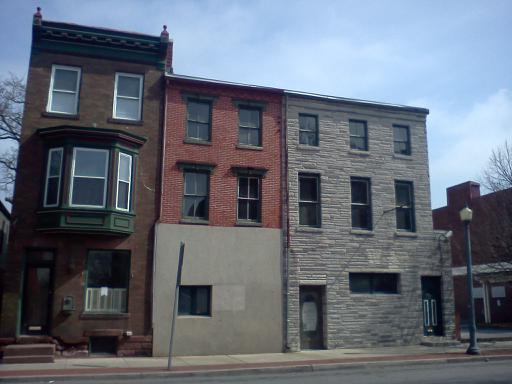
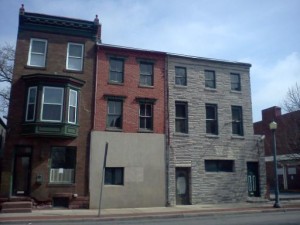
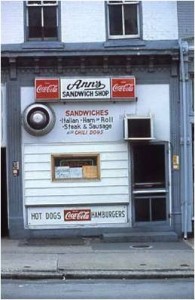
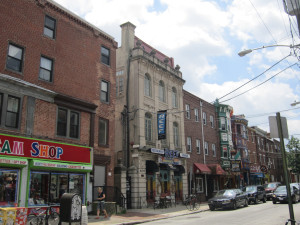
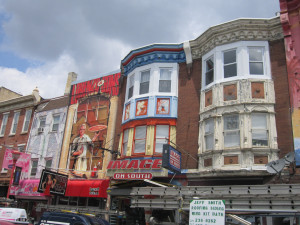
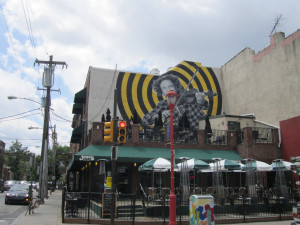
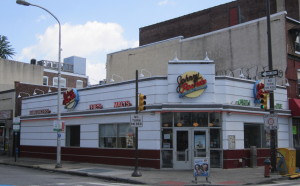
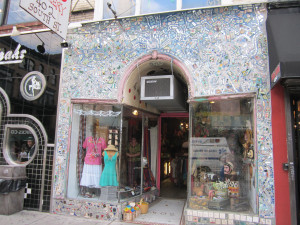
it is a paradox that when preservation policy plays freeze frame, it interrupts the evolutionary process that created the buildings and communities that it seeks to preserve.
and ironically, at least in my local historic districts of the DC suburbs, the majority of the housing stock is influenced by the craftsman era–which was an explicit reaction to then prevailing styles.
in the words of Gustav Stickley–the most influential proponent of that movement, “…it is right to build houses as people wish them…to subordinate tradition…” how then are we to reconcile that spirit with mandates to build “in character with” prevailing styles?
if preservation policy is to be successful, it must look forward as well as backward. What will historic districts be like, one hundred years from now? as it is currently administered, very likely, enclaves for the very wealthy–or else abandoned–in favor of communities that were allowed to grow and evolve freely and organically.